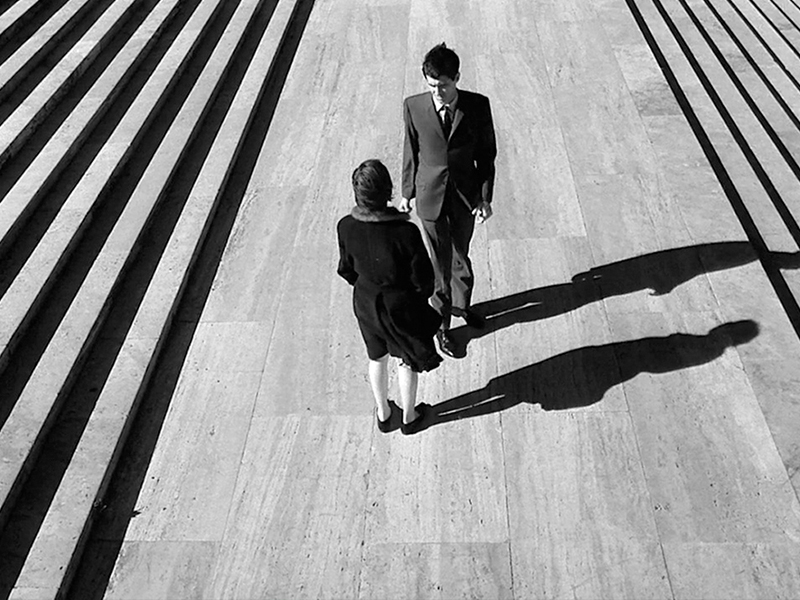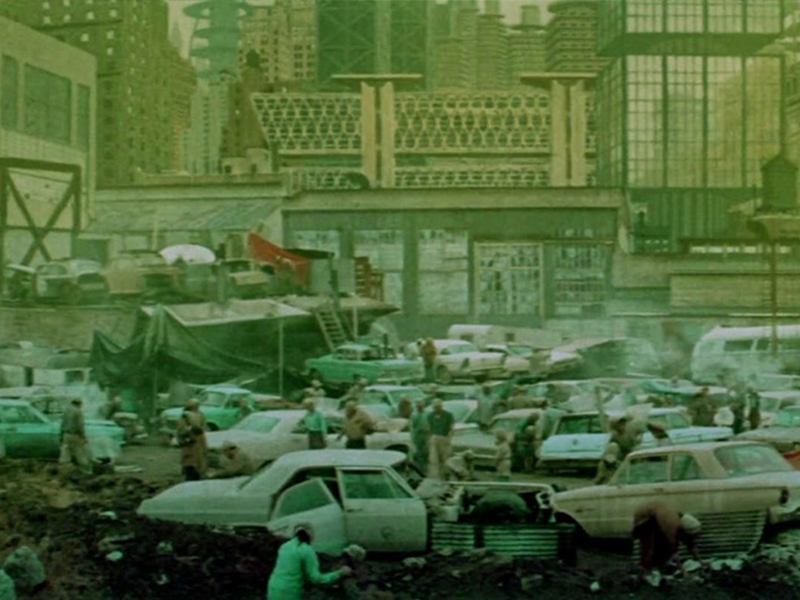The tent of Mad Hatters. Conspiracy theories in cinema | Panorama
From the age of silent cinema to the present: classical masterpieces, remakes, the rise of certain genres, our column “Panorama” takes a ride through history and sets its sights on films that were not given enough attention at the time of their release, or, conversely, on discussions that were never brought to light.
Today we dive into the infinite abyss of conspiracy theories in cinema, seeking to discover, at least in part, the source of distrust in the authorities, why the state is seen as a seven-headed dragon. A composite sketch of the conspiracy theorist and the enemy, Manichaean theories, a tent of illusionists set up in Washington’s courtyard and, last but not least, body horror.
Kafkaesque
Conspiracy is the depiction of a collective or individual fantasy in which the civilian seeks alternative versions to history so that events become linear; the amateur sleuth does not accept that the world is ruled by chaos, but looks for the spider’s web, the ground zero for events, the trigger. Most of the time, there is a grain of truth to these prefabricated narratives, which only makes it worse. Working on the principle of the megaphone, they survive by a collective effort; hence the story versions undergo mutations or branch out in parallel with other conspiracy theories, however outrageous, giving rise to hallucinations that remind of the Mad Hatter in Alice in Wonderland. They stem from a lack of trust in the official discourse, from the belief that information is being concealed. The conspiracy theorist will always look for symbols and clues in every piece of information, and the fabrication too will rely on this parallel logic where everything seems to suddenly come to light. The conspiracy narrative is a fountain of epiphanies – at the end of the resolution, the inexhaustible search for the truth brings enlightenment, even though the hero often dies proving they were right (like in The Manchurian Candidate). No hypothesis is too wild, too out of place; the more outrageous it is, the more comforting it is.

Early cinema comprises a number of films that depict in various forms a conspiracy, including a Kafkaesque bureaucratic hell (The Trial, dir. Orson Welles, 1962), a satanic conspiracy (Rosemary’s Baby, dir. Roman Polanski, 1968), an adultery plot discovered by an outsider (The Conversation, dir. Francis Ford Coppola, 1974). It is quite possible that Orson Welles’ film is the most cited anti-system film, precisely because of the walls that K, the protagonist, runs into in his relationship with the state; Kafka is invoked whenever the character comes face to face with the absurdity of existence or wakes up in a “guilty without guilt” situation, and the conspiracy rises from the unsettling feeling that something is off (the traffic lights flash uncontrollably, the dumpster is moved thirty centimeters away, people seem as if under hypnosis). The conspiracy is based on paranoia – and the feeling of sharpening the senses. It’s hard to pin down when the first conspiracy film actually appeared, although most credit Oliver Stone and his JFK (1991). Kennedy’s death is by no means the first conspiracy to have been discussed, but it lines up with two major phenomena that will influence traffic and access to information: the advent of the Internet (for example, the USENET network, an Internet community created in 1979 that promotes free discussion and sharing music, photos, documents) and the proliferation of digital technology (Handycams, now accessible to anyone, allowed people to make all sorts of amateur videos where they could share their theories, which will later evolve into an indefinite amount of video essays, more polished, more niche, and in the vein of investigative documentaries, which now populate Youtube). Let’s take a look at the rise of Mae Brussell, the first conspiracy theorist, who dissected such theories on her radio show and came up with new hypotheses about Kennedy’s assassination; such forums contributed to Stone’s premise in JFK, namely the obscure hypothesis that the CIA had planned the murder of the American president. I would also point out that another influence must have been Barry Levinson’s political satire, Wag the Dog (1997), in which a team of professionals (a producer, played by Dustin Hoffman, and a media adviser, played by Robert de Niro) sets up a fictional tent in Washington’s courtyard and invents an entire war in Albania, shown only in pictures, to divert attention from the president’s adultery. Last but not least, the mystery kept by the authorities on so many burning topics for public opinion (are there aliens? Why are there so many unknown details to the 9/11 attack?) unequivocally determines the emergence of conspiracies. And while most of them have harmless potential, Stone’s film, for example, led to reopening the confidential files of the president’s assassination and making them public. As we will see, much of the subsequent films appear in the late ‘90s, early 2000s, there is a boom in conspiracy films.
A possible classification
In fiction cinema, conspiracies are distinguished according to the way the actor is affected by the system:
a) the conspiracy concerns them directly: the moving of the dumpster, the flashing of the traffic lights, these acts are intended for them specifically, everything is a Truman Show-type fantasy in which the state must maintain the illusion of normalcy. “A megalomaniac view of oneself as the Elect, wholly good, abominably persecuted yet assured of ultimate triumph.” (Norman Cohn, The Pursuit of the Millennium). In this case, the individual is always racing the clock (in Bourne, the building designer shuts them down as the spy desperately tries to get out of them); it is the tragic condition of the individual who, although messianic (they are the only one who holds the information and, therefore, the only one who can fight the system), the state is monstrous, multiplies and can be everywhere at the same time.

Case study: Conspiracy Theory (dir. Richard Donner, 1997), in which the conspiracy theorist is played by Mel Gibson. The protagonist assembles all possible conspiracies, is up to speed with all of them (the Vatican, pharmaceuticals, CIA, and so on). The great twist of the film is that the civilian, an ordinary taxi driver, who keeps his refrigerator locked up out of fear of being poisoned by the state, has, of course, good reasons for his intense paranoia (the government hunts him down because he is part of the famous brainwashing experiment that allowed the army to create remote-controlled assassins – the hypothesis of the Manchurian candidate). Still, unlike The Manchurian Candidate (originally made in 1962, remade in 2004 by Jonathan Demme, set in McCarthyism, where there was tension over the Cold War), here, Jerry is less aware of his past, and his memory comes back in pieces.
b) external conspiracies (outsider syndrome): the conspiracy does not concern the protagonist directly, it is not their personal fantasy, but they end up discovering it incidentally, thus attracting the enemy’s attention; from that moment, the protagonist becomes a target.

Case study: They Live (dir. John Carpenter, 1988). According to Richard Hofstadter in Paranoid Style in American Politics, “the enemy is a kind of amoral superman: sinister, ubiquitous, powerful, cruel, sensual, luxury-loving (…) unlike the rest of us, the enemy is not caught in the toils of the vast mechanism of history, he is a free, active, demonic agent”. The passage from Hofstadter fits perfectly with the idea of The Other in They Live. The film follows a loner, Nada (Roddy Piper), a nomad who keeps moving his nest from town to town; he ends up working on a construction site and comes across a pair of seemingly ordinary glasses, but it turns out that once you put them on, you can see the subliminal messages behind all audiovisual products (Be obedient, Don’t fight back, Buy this thing, Align with the rest, etc.). Moreover, ordinary people, seen under this lens, look like aliens; you don’t have to look suspicious to be an alien, even the most harmless old lady in the supermarket can announce through her watch that you can see her and call the UFO authorities. Without glasses, everything seems normal – so the alien appearance is just an inverted version of each. Carpenter had a pretty clear basic message, namely that you have to take the surrounding reality with “a grain of salt” because media propaganda is real (an underlying theme resumed in the Matrix franchise 11 years later); moreover, he showed as graphically as possible how much humans fear that aliens might be among tus, that they might be the true masters of the Universe and that there’s nothing to help us distinguish them from ordinary people.
Body Horror

Which brings me to body horror and paranoia about ingesting pills, getting shots, and narcotics. One of the recurring themes in conspiracy films is related to the government testing all kinds of alpha programs on the individual – they are a guinea pig for science without even realizing (the Manchurian candidate discovers an implanted chip under the skin, which is triggered, ironically, when the person is called by name). Chips or substances are meant to slow down the character who, as I said, is on a mission against the clock, has no time to lose. In Soylent Green, a police officer accidentally discovers that the green, post-apocalyptic food sold by the government is literally produced from the remains of the dead, which in turn accelerates the death of those who eat it (the year is 2022, by the way, and there’s a severe shortage of food caused by a massive drought, so then, the only solution is food rationing, which comes in the form of green wafers). Such films fuel conspiracy theories – and conspiracy theorists will often set them as an example for their own beliefs, with the infallible argument that films “could very well prepare us for life”. Let’s not forget that our entire history is shrouded in conspiracies and plots – distrust in the authorities and being on the alert are recurring in literature and cinema (from George Orwell’s 1984 to Margaret Atwood’s The Handmaid’s Tale). In these narratives, the authority is always the enemy, and the individual is a rogue – it’s their job to decipher its operational code. What’s more, even Manichaean stories from childhood can be seen as mini-conspiracies – in the Symposium on Conspiracy Theories: Causes and Cures, Cass R. Sunstein and Adrian Vermeule talk about Santa Claus’ existence as one of the biggest inventions, which parents share with children to maintain the magic of the holidays. Fathers and mothers are undercover agents, and in order to receive presents, children will have to behave and listen to them, otherwise, Santa Claus won’t pass by their house. Although immaculate, we are talking about a tiny example of control that people apply from an early age – no wonder, then, that it’s so easy to get sucked in a conspiracy today, whatever that may be; these stories, no matter how mind-boggling, are designed to give a temporary meaning to people who are bored with the current reality, which is perhaps too trivial to be explored as it is.
Journalist and film critic, with a master's degree in film critics. Collaborates with Scena9, Acoperișul de Sticlă, FILM and FILM Menu magazines. For Films in Frame, she brings the monthly top of films and writes the monthly editorial Panorama, published on a Thursday. In her spare time, she retires in the woods where she pictures other possible lives and flying foxes.
